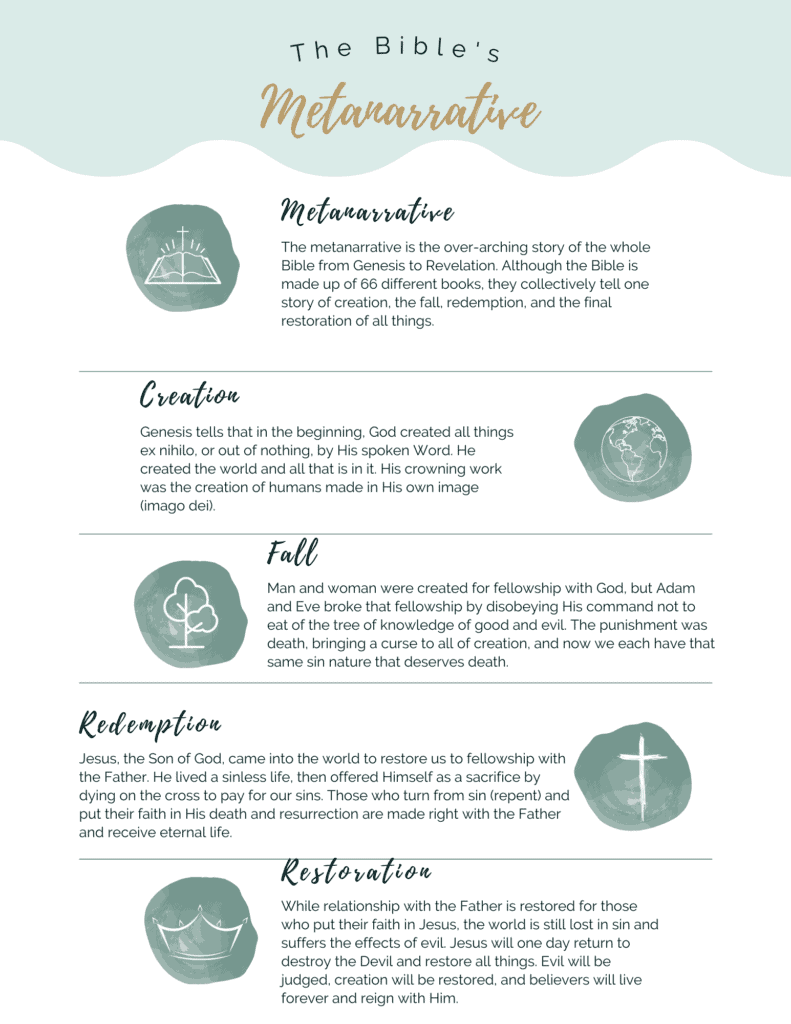Understanding the Metanarrative of Scripture
Which book of the Bible do you read the least? If you’re like me, you tend to gravitate toward the more easily-applicable books of Scripture—Proverbs or the Gospels or the Epistles of Paul. But perhaps you read very little of Habakkuk or Ezekiel.
When I got serious about Bible study, I learned that we need all of the Bible, even the more difficult parts, to get a complete understanding of who God is and what that means for our lives.
When we consider the metanarrative or the overarching story of the Bible, every verse has a place, and all of it is relevant and valuable for spiritual growth.
In Bible study, we go deep into verses, passages, chapters, and books of the Bible. This kind of study is important for growing our faith as we learn and apply the Scriptures to our lives.
When we use a Bible reading plan to read through the whole Bible, we go wide, getting a big-picture view of how all the Bible is about Jesus. Although the Bible is made up of 66 different books written in several different genres, they all tell one beautiful story of creation, fall, redemption, and restoration.
The beauty of understanding this big-picture view of Scripture is that it makes some books of the Bible easier to understand because they ALL fit into this metanarrative.
For instance, sometimes we don’t understand how some of the Old Testament law or some of the prophecies to Israel and other nations are relevant to us. So, we read very little of the parts of the Bible that don’t seem as applicable to our day-to-day life.
But even though some of the Scriptures don’t apply specifically to us because they were written to Israel or to a specific individual, that doesn’t mean they aren’t relevant or valuable or worthy of our time and attention.
“All Scripture is God-breathed and useful for teaching, rebuking, correcting, and training in righteousness.”
2 Timothy 3:16, NIV
So we know that it’s all valuable in some way, even the commands to ancient Israel and the prophecies to them and other nations. All of it has a place in the metanarrative. Some Scriptures show mankind’s need of redemption. Some show the attributes of a patient, faithful, and just God. And all the Old Testament points to Jesus in some way.
“And beginning with Moses and all the Prophets, he explained to them what was said in all the Scriptures concerning himself.”
Luke 24:27
“He said to them, “This is what I told you while I was still with you: Everything must be fulfilled that is written about me in the Law of Moses, the Prophets, and the Psalms.”
Luke 24:27
The entire Old Testament is the history of God working through the Jewish people to bring redemption through His Son Jesus.
For instance, the first five books serve to introduce the foundational truths of creation and the fall, while also pointing toward the redemption that is to come. Jesus is at creation with the Father in Genesis 1; then we see the first prophecy of His coming in Genesis 3:15.
We learn about judgment, covenant, promise, God’s nature, freedom, holiness, and relationship all in the first 5 books, the Pentateuch or the Law of Moses.
The historical books of the Old Testament gives us insight into how God chose a people to be set apart for Himself, what happens when people do what is right in their own eyes, the consequences of rebellion against God, the division and eventual downfall of Israel as a kingdom, but also the covenant God made with David to bring a King through him who would reign forever and restore the fellowship with God that had been broken in the Fall.
The wisdom and poetic books show us how we should live in light of these truths. We learn about suffering and faithfulness, wisdom, worship, the meaning of life and the beauties of married love.
The prophetic books of the OT point toward the coming of the One who will restore all things. The prophets before Israel’s exile called them to repent and return to God. Those who prophesied during the period of Israel’s exile encouraged them to live rightly in light of their judgment and to endure, offering hope of future restoration. After the exile, the prophets encouraged the people to return and to rebuild and restore worship because One was coming who would bring light into the darkness.
The Gospels give us the historical account of Jesus Christ, the Son of God who redeems us through His sacrifice and tell us of His teachings and about those who followed Him.
Acts is a historical book that details the spread of the Gospel, the early church, and the missions of the apostles.
The New Testament epistles (letters) provide instructions in how we should live in light of His redemption and future restoration.
Revelation reveals to us the ultimate reign of Jesus and restoration of all things, including the creation itself.
Understanding this over-arching story helps us see the value and relevance of every book by identifying where it fits into this metanarrative. Reading some of the books we avoid becomes a little easier and more exciting when we understand their place in God’s big story. As we read, we look for what the text tells us about God, about mankind, and about the Gospel.
I hope this helps to both inspire and challenge you to read all the Bible in its context and grow your faith. And if you want to learn more about the overall context of the Bible, get our Anatomy of the Bible course.


